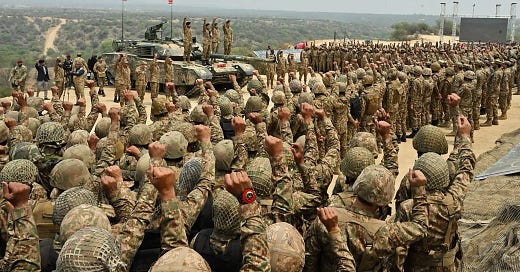The Man Behind the Uniform: Gen Asim Munir’s Return to Zia-ul-Haq's Doctrine
In this Paigham, we shift focus from the India-Pakistan equation for now to Gen Asim Munir, Pakistan’s de facto leader, who, much like Zia, is reasserting military control and ideological dominance.
Much has already been said, unsaid, retracted, and berated about India-Pakistan ties as the historic rivals find themselves on the brink of yet another military confrontation. Policy wonks, myself included, have tried to dissect this latest flare-up through the varied lenses of defense, strategy, history, sociology, and foreign policy across platforms.
This Paigham seems like the right occasion to shift the focus off the India-Pakistan equation for a moment, but to General Asim Munir, the de facto leader of Pakistan, who now stands at the helm of this heated conflict. And to the military institution that, yet again, defines the trajectory of the Pakistani state.
Without reaching too far back, General Munir appears to be borrowing liberally from the playbook of General Muhammad Zia-ul-Haq, Pakistan’s long-serving military dictator from 1977 to 1988. Munir’s posturing of moral absolutism and Islamist fervor arguably resembles a return to the doctrinal template of the Zia era, where the military cast itself not only as the guardian of the state but also as the custodian of the nation’s ideology.
Both leaders have embraced religious rhetoric to legitimize their authority and emphasized the centrality of the Kashmir issue in their strategic worldview. Munir, like Zia, invoked the two-nation theory and described Kashmir as the “jugular vein” of Pakistan, a phrase he repeated in a provocative address just days before the Pahalgam terror attack, echoing Zia’s use of Islamic identity to frame national security imperatives. Munir’s background as a Hafiz-e-Quran and his education in a madrassa further reinforce his image, drawing parallels with Zia’s Islamization drive and efforts to infuse the military establishment with religious ideology. Zia’s era saw the introduction of Sharia laws, the expansion of military courts, and use of religious rhetoric.
Zia’s “bleed India with a thousand cuts” doctrine, supporting proxy warfare in Kashmir, significantly altered the region’s security dynamics and left behind a legacy of militant networks that persist to this day. A similar accusation has been leveled against Munir in the wake of the unprecedented identity-based targeting of tourists in Pahalgam. While Munir has not formally imposed martial law or seized power through a coup, he has consolidated his hold on the country through institutional control, legal amendments, and the expanding influence of the military over civilian affairs.
Internal Tensions and External Pressures
That said, it is also vital to note that Munir operates in a more complex environment, facing India’s aggressive shift in military posture, an economic crisis, international scrutiny, growing militancy, and a restive society. Unlike Zia, an overt military dictator, Munir has maintained the appearance of constitutional rule while exercising de facto control over the state.
It would be unfair not to acknowledge the cracks emerging in the form of quiet defiance and political grievances, evident in the enduring support for Opposition leader Imran Khan, following his fallout with Munir, and in the allegedly forced resignation of a Lieutenant General for purportedly speaking 'against the Army' at the Corps Commander Conference in March 2024.
At a time when headlines are dominated by military strategies and foreign policy commentary, it becomes even more critical to look beyond the battlefield. Understanding the man behind the uniform, his ideological convictions, institutional power, and political compulsions remains central to comprehending the deeper dynamics of this conflict. This goes beyond India-Pakistan hostility; it is about how external escalation can serve internal consolidation. Pakistan’s actions, while driven by tit-for-tat tactics with India, also reflect efforts to reset domestic control, relegitimize military dominance, and potentially revive a historic template. In that light, understanding Munir is essential to understanding the direction Pakistan might take.
As India and Pakistan toe the line of diplomatic severance in light of rampant disinformation and disarray, we continue to closely monitor the developments. Do write to me if you'd want me to break down any aspect of this unfolding situation.
More from Takshashila’s Desk
The Diplomat | After Pahalgam, India Faces Tough Security and Diplomatic Choices - by Aishwaria Sonavane
NDTV | There's A Caveat In Pak's Suspension Of Simla Pact - by Aishwaria Sonavane
Moneycontrol | America’s Messy Afghan Withdrawal has Left the Region Awash With Arms - by Aishwaria Sonavane
Takshashila Institution’s All Things Policy | Operation Sindoor: Rethinking India’s Military Doctrine Against Pakistan with Aishwaria Sonavane and Dr Happymon Jacob
The Mint | Operation Sindoor Sets a New Normal For India's Strategy by Nitin Pai
The Mint | India Must Stay the Course in its Old Contest with Pakistan by Nitin Pai





On May 10, 2025, after days of intense cross-border hostilities, India and Pakistan agreed to a “full and immediate” ceasefire. The announcement was made near-simultaneously at 5:00 p.m. Pakistan Standard Time, with US President Donald Trump first making the news public, quickly followed by confirmations from Pakistani Foreign Minister Ishaq Dar and Indian Foreign Secretary Vikram Misri. Trump highlighted the role of US mediation in achieving the agreement
Despite the ceasefire, explosions and renewed violence were reported within hours in Indian-administered Kashmir, particularly in Srinagar and Jammu. Indian officials, including Foreign Secretary Misri, claimed there were “multiple breaches” by Pakistan and called for corrective action, stating that the Indian military was responding to these violations.
Pakistan, meanwhile, denied any violations and accused India of breaking the agreement, with its foreign ministry emphasizing a commitment to the ceasefire and calling for any disputes to be resolved through dialogue
If Pakistan is or is not involved, it remains the case that India was unable to prevent attacks from occurring within its own territory, underscoring the ongoing security challenges and the fragility of the ceasefire
https://macropakistani.substack.com/p/pakistan-and-india-reach-a-tipping/comment/116164128?r=5ckbt&utm_medium=ios